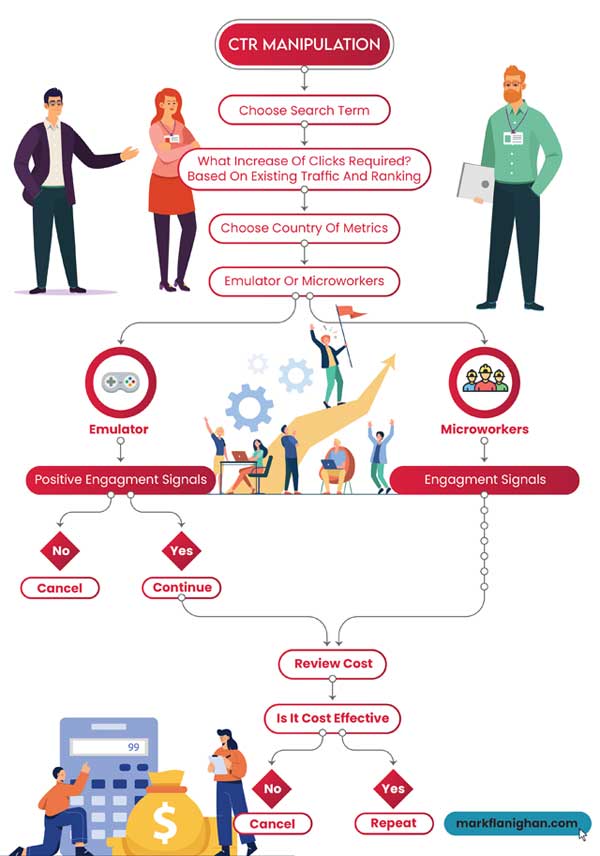Achieving Success With Targeted CTR Manipulation
The optimization of click-through rates (CTR) is a crucial undertaking for brands intending to improve their electronic visibility and make best use of engagement. Targeted CTR control encompasses a variety of techniques, from data-driven ad placements to the growth of compelling material tailored to certain audiences.
Comprehending Click-Through Rates
Click-through rates (CTR) work as a vital statistics in digital advertising and marketing, mirroring the effectiveness of on the internet web content in driving user involvement. This metric is determined by dividing the number of clicks an advertisement or link receives by the overall number of perceptions, expressed as a percent (CTR Manipulation Service). A higher CTR suggests that the web content reverberates well with the target audience, motivating them to act
Recognizing CTR is vital for marketers aiming to enhance their campaigns. Numerous factors affect CTR, including advertisement placement, style, and the importance of the web content to the audience's interests. Compelling headings and visually enticing photos can dramatically boost the chance of users clicking on a web link.
Additionally, the context in which the material is presented plays a vital duty in establishing CTR. Ultimately, a detailed understanding of CTR empowers online marketers to improve their approaches, making certain that digital projects accomplish their wanted results effectively.
Significance of CTR Manipulation
In the affordable landscape of electronic advertising and marketing, the adjustment of click-through prices (CTR) has actually come to be a crucial technique for enhancing project performance. CTR functions as a vital efficiency indication, reflecting the efficiency of on-line promotions and content in attracting customer involvement. A higher CTR not only represents better interest but likewise can cause boosted search engine rankings and reduced cost-per-click (CPC) rates, thereby maximizing overall advertising and marketing spending plans.
The relevance of CTR adjustment depends on its capability to notify marketing professionals about customer preferences and actions. By analyzing CTR data, businesses can identify which aspects of their campaigns resonate most with their target market. This understanding enables more informed decision-making and the allocation of resources to the most effective networks.
Furthermore, efficient CTR adjustment promotes a competitive benefit. Hence, grasping CTR adjustment is not just useful; it is vital for achieving continual success in digital advertising efforts.
Strategies for Targeted CTR
Attaining targeted click-through prices (CTR) requires a calculated method that encompasses numerous methods customized to certain target market sectors. One efficient strategy is enhancing advertisement positionings by using data analytics to determine high-performing networks. By concentrating initiatives on these networks, marketing professionals can enhance visibility and boost engagement.
One more important method is crafting compelling headlines and contacts us to action (CTAs) A/B testing various variants can reveal which combinations resonate most click reference with the target market, thereby driving greater CTR. Furthermore, including visual aspects such as eye-catching images or video clips can significantly enhance appeal, making content a lot more engaging and shareable.
Customization also plays an essential role; making use of individual information to create tailored material can cultivate a feeling of importance, encouraging clicks. Moreover, leveraging social proof via reviews and user-generated web content can build trust, inevitably improving CTR.
Studying Customer Behavior
 Comprehending individual habits is vital for enhancing advertising and marketing techniques and boosting overall efficiency. By assessing just how individuals engage with content, online marketers can acquire important understandings into preferences, inspirations, and discomfort factors. This expertise makes it possible for the advancement of more targeted campaigns that resonate with certain audience sectors.
Comprehending individual habits is vital for enhancing advertising and marketing techniques and boosting overall efficiency. By assessing just how individuals engage with content, online marketers can acquire important understandings into preferences, inspirations, and discomfort factors. This expertise makes it possible for the advancement of more targeted campaigns that resonate with certain audience sectors.To successfully analyze customer behavior, different tools and techniques can be used. Internet analytics systems give data on individual interaction metrics such as click-through prices, bounce prices, and time invested in web page. Heatmaps and session recordings allow marketing experts to imagine user communications, revealing which elements stand out and which might be forgotten.
Furthermore, user comments with studies and comments types can provide qualitative understandings, improving the understanding of individual belief and contentment. Segmenting customers based upon habits, demographics, and passions can further fine-tune targeting efforts, tailoring material to satisfy diverse requirements.
Ultimately, continuous analysis of customer actions is critical for adapting advertising techniques in real-time. As user patterns progress, staying in harmony with these modifications makes certain that campaigns continue to be appropriate from this source and efficient, promoting a deeper connection with the target audience. This foundational understanding establishes the stage for the effective application of targeted CTR manipulation methods.
Gauging Success and Adjusting Methods
Gauging success in targeted advertising and marketing projects requires a critical approach that incorporates performance metrics with recurring analysis. Trick efficiency signs (KPIs) such as click-through rates (CTR), conversion rates, and consumer procurement prices need to be kept track of constantly to assess the effectiveness of adjustment approaches. By establishing a standard, marketers can analyze adjustments in CTR and determine fads that indicate successful involvement or prospective shortcomings.
Routinely evaluating these metrics permits the prompt change of methods. If a particular project reveals a considerable drop in CTR, it may indicate the demand for innovative alterations or discover this a reevaluation of targeting parameters. Utilizing A/B screening can additionally refine approaches by contrasting variants of ads or landing web pages, giving insight right into what resonates best with the target audience.
Additionally, incorporating qualitative responses through surveys or user meetings can supplement quantitative information, using an extensive view of audience assumption. Eventually, the ability to iteratively assess and refine methods based on real-time information fosters an extra responsive marketing strategy, making sure that campaigns stay lined up with business purposes and target market preferences. This flexible approach is crucial in achieving sustained success in targeted CTR adjustment.
Conclusion
In conclusion, targeted CTR adjustment is necessary for enhancing digital marketing initiatives - LinkDaddy CTR Manipulation. Ultimately, successful CTR control not only increases exposure however additionally fosters trust and credibility, thus contributing to continual growth in affordable markets.
 Targeted CTR control encompasses a variety of strategies, from data-driven ad positionings to the advancement of engaging content tailored to specific target markets.Click-through rates (CTR) offer as a vital statistics in digital marketing, mirroring the efficiency of on the internet web content in driving user interaction. A higher CTR shows that the web content resonates well with the target audience, motivating them to take action.
Targeted CTR control encompasses a variety of strategies, from data-driven ad positionings to the advancement of engaging content tailored to specific target markets.Click-through rates (CTR) offer as a vital statistics in digital marketing, mirroring the efficiency of on the internet web content in driving user interaction. A higher CTR shows that the web content resonates well with the target audience, motivating them to take action.CTR serves as a crucial efficiency sign, mirroring the performance of on-line advertisements and content in attracting customer interaction.In final thought, targeted CTR manipulation is essential for maximizing digital advertising and marketing efforts.